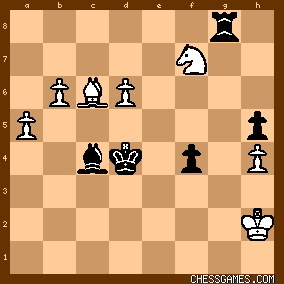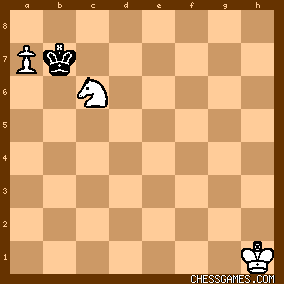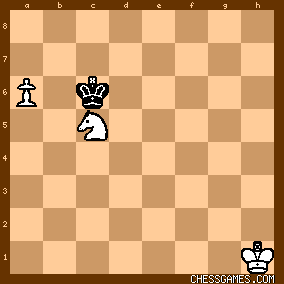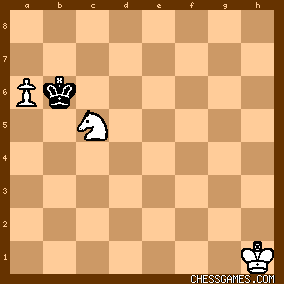|
< Earlier Kibitzing · PAGE 2 OF 2 ·
Later Kibitzing> |
| May-27-09 | | PinnedPiece: I like this game!
Thought of a pun, too, a bit late for the 2009 contest, ah well. "Persistence of Mamedyarov" |
|
Aug-06-09
 | | JointheArmy: Impressive combination from Mamedyarov. |
|
| Aug-06-09 | | arsen387: A very nice game, 38.Ng4 left me in total amazement, in that position I would have surely played smth uninspiring like Nxf5 :) The final N maneouvre is also great. But I like this romantic masterpiece played again by these 2 better Bacrot vs Mamedyarov, 2009 |
|
| Aug-06-09 | | sfm: sfm: Neat counting! 73.d8Q+ wins - on a single tempo! Black eat everything on b8, then the a-pawn and then runs towards the king side. White eats the f-pawn and then play 79.Kxh5, with the black king on the c-file. If Black had made it to the d-file it would be a draw. |
|
| Aug-06-09 | | eaglewing: <Jimfromprovidence: Why not 66. ... f4? and Why not 72 b8Q?> I agree with you with respect to Shipov's analysis, that move 66 by black decides the fate of the game. I'm astonished Bacrot chose Bxd5 at that point, after all, the remaining game line is not difficult to envision for experienced players, because, while not strictly enforced like a mate combination, White needs to push his pawns and then follow-up with Ne6-c5. Otherwise White would be in danger to lose these pawns first and then the game. Your question is, if the the move order in the Shipov-line, 66. ... Rg8 and 68. ... f4 is important, or could be reversed with starting 66. ... f4. I had a look at 66. ... f4 67. Nf7+ Kd4 68. d6, but it does not work. With f4, square e4 is still not accessible for the knight. As far as I can see the Shipov line is still the line of choice, the different move order cannot be taken advantage of by White. Nevertheless, to be sure, ask Fritz about it. Regarding your 72 b8Q instead of a7:
Yes, f1N+ is required, but fine and easy for a draw after Kh1 Rxb8 a7 Rg8 a8Q Rxa8 Bxa8 Ng3+ Kg2 Nf5. Note: Not f1N+ Kh3 Rxb8 a7/d6, due to Rg8/Rg3#. |
|
| Aug-06-09 | | JohnBoy: <JfP> and <notyet> are after different things. I am with Jim in wishing to understand where exactly Bacrot lost the thread. At the site mentioned above, http://chessok.com/broadcast/?key=p..., Rybka gives a different drawing line for black at 66, and does not even note 66...f4. This is, of course, immediately following white's howler at 66 (missing 66.Nf7+). Maybe one of you engine runners can scour this for possibilities. White's 36th, in anticipation of surrendering up the X, indicates a bold and admirable plan. Bravo Shak. |
|
| Aug-06-09 | | SuperPatzer77: It is one of the instructive games I've learned.
After 73. b8=Q+, White forces simplification that leads to the easy pawn endgame for White. <Notyetagm> Well-done, you've shown us the excellent analysis of three diagrams so, you're right that Bacrot (Black) had no choice. Black was forced into simplification that gives White a easy pawn ending. SuperPatzer77 |
|
| Aug-06-09 | | Big Easy: Can someone please explain the following:
Why doesn't black respond to 37.Rxe7 with 37...Rxe7 instead of the move played, 37...Qxe7? Then when white plays 38.Ng4 there is no discovered attack on the black queen, and the bishop on c3 remains protected. What am I missing? |
|
| Aug-06-09 | | kevin86: After white captures the rook and the pieces are cleared from the queenside,white captures the black pawns and then races the king to g7-it is close. If black can reach f8,he draws,but he comes up short. Sacre Bleu! |
|
| Aug-06-09 | | Big Easy: Never mind on my last post. 38.Qxd6
Duh! |
|
| Aug-06-09 | | SuperPatzer77: 73. b8=Q+ Rxb8, 74. Nxb8 f4, 75. Nd7! allows the White King to attack Black's two remaining pawns and then the White h-pawn goes queening. Black cannot capture the White Knight at d7 after 75. Nd7! because if Black captures him at d7, the unstoppable White a-pawn goes queening. SuperPatzer77 |
|
| Aug-06-09 | | eaglewing: <SuperPatzer77: 74. Nxb8 f4, 75. Nd7> Or you just ignore the useless move f4, which, agreed, would kind of allow you to save the white knight, and just play Kg2 and the kingmarch. It still works. Or, btw, why not 74. Nxb8 f4 75. a7 Kb7 76. Nc6 to punish f4? |
|
Aug-06-09
 | | Jimfromprovidence: I must have been in a crappy mood that day!
<eaglewing> <...I had a look at 66. ... f4 67. Nf7+ Kd4 68. d6, but it does not work.> Can't black now play 68...Rg8 and still hold the draw? 
click for larger view |
|
| Aug-06-09 | | eaglewing: <Jimfromprovidence> Sorry, that I've been unclear: The idea with 68. d6 does not work for White! In fact, Rg8 and the soon following Kc5 will get White in trouble, so White should follow the Shipov-line, too, and play 66. ... f4 67. Nf7+ Kd4 68. b7 Rg8 and only the move order has switched. |
|
| Aug-06-09 | | lzromeu: Great. At first moment I think this game ends draw, but black can't stop the king and h-pawn march. |
|
| Aug-06-09 | | lzromeu: While It's hard to me understand the game at move 73 (why not draw), others are analyzing the 66th. move. Great! |
|
| Aug-06-09 | | SuperPatzer77: < eaglewing: <SuperPatzer77: 74. Nxb8 f4, 75. Nd7> Or you just ignore the useless move f4, which, agreed, would kind of allow you to save the white knight, and just play Kg2 and the kingmarch. It still works. > See the diagram below:

click for larger viewSee where the Black King is located: the area of 9 squares (a8, b8, c8, a7, b7, c7, a6, b6 and c6). See that the Black King is not able to get out of this area because the White a-pawn threatens to go queening if the Black King captures the White Knight at d7 or gets out of the area of 9 squares. So, Black isn't able to save the pawns or attack the White a-pawn and the White Knight. White attacks the two Black pawns effortlessly and pushes his h-pawn to the queening square of h8. <eaglewing> I don't ignore the Black f-pawn because the White King is able to stop this advancing f-pawn so easily. However, Black is not able to save his f-pawn because of the dangerous White a-pawn. <eaglewing> My simple analysis works like a charm. Your analysis is OK as well. SuperPatzer77 |
|
| Aug-06-09 | | SuperPatzer77: <eaglewing> You need to take a look at an important and careful analysis below: It is very tricky for the average chess players. The chess masters know how to do this but the chess beginners don't. It is very instructive for the average players. 
click for larger viewWhite to move and win
1. a7?? Kb7, 2. Nc6 - White cannot win because White isn't able to cut the Black King off of the a8 square. 
click for larger viewCorrect is below:
1. Nd7! Kc6, 2. Nc5! - White is winning.

click for larger view<eaglewing> See the two different diagrams below: 
click for larger viewWhite draws

click for larger viewWhite wins
SuperPatzer77 |
|
| Aug-06-09 | | eaglewing: <SuperPatzer77>: You misunderstood me. Effectively, my question was, why do you analyse 73. b8=Q+ Rxb8, 74. Nxb8 f4? What do you think f4 does accomplish for Black? Is there any kind of idea hidden to save Black (while still failing)? Especially compared to the natural KxNb8, why do analyse f4 at all? Is it a kind of "Zwischenzug", so you are still able to follow-up with KxNb8? My answer is simple: No, no, never! f4 is in the same league as Kc8: Not useful. |
|
| Aug-06-09 | | eaglewing: <SuperPatzer77>: Sorry, you invested time in your last post for no gain, because, my line with a7 and Nc6 included ofcourse the position WITH the pawn h4 for White. But I confess, you are right, Nd7/Nc5 is as good as a7/Nc6 for holding the pawn and in your example even better. |
|
| Aug-06-09 | | JohnBoy: <SP> - in your above analysis (two posts previous) comparing 1.a7 with 1.Nd7, after 1.Nd7 Kc6, 2.Nc5 is totally unnecessary. Both the b and d files are inaccessible to black. The king is forced to shuttle between c6 and c8. Anything else and the pawn queens. White just brings the king up without delay. |
|
| Aug-06-09 | | SuperPatzer77: <eaglewing> You misunderstand what I'm trying to show you if Black chooses 74...f4 instead of 74...Kxb8. I mean I just want to show you another analysis when it is 74...f4 instead of 74...Kxb8. <eaglewing> What would you do if Black would choose 74...f4??? SuperPatzer77 |
|
| Aug-06-09 | | eaglewing: <SuperPatzer77>: Misunderstood! Agreed. However, 74...f4 is meaningless analysis for me, because it accomplishes nothing positively for Black. If you just wanted to show the 75. Nd7 analysis, I would have expected a comment like: If we make a (meaningless) waiting move like f4, then Nd7 demonstrates nicely the untouchability of the a-pawn or if it would be White's move, then Nd7 ... The way you wrote it, it led to, well, a misunderstanding. Anyway, what would I have answered to f4? Kg2, because I need the King anyway to convert the win, time to march up the board. |
|
| Aug-06-09 | | WhiteRook48: funny knight manuevering |
|
| Aug-06-09 | | SuperPatzer77: <eaglewing> You're right that 74...f4 is meaningless. I just choose one of Black's tries - 74...f4 instead of 74...Kxb8. 74...Kxb8 is Black's best try but White has a single tempo. After this move, the White King is ready to march on and attack. 73. b8=Q+!! is a key move that provenly gives White a tempo. <eaglewing> we agree that 74...f4 is meaningless. I just choose another try for Black - 74...f4. SuperPatzer77 |
|
 |
|
< Earlier Kibitzing · PAGE 2 OF 2 ·
Later Kibitzing> |





